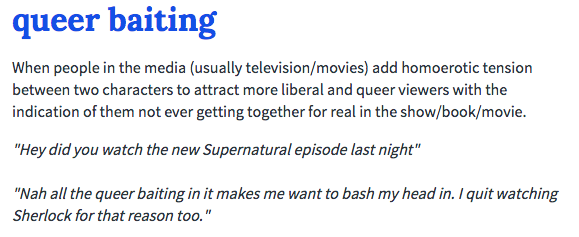What is queer-baiting? A simple definition is when filmmakers and showrunners tease out the possibility of an LGBTQ relationship through subtext and innuendos, without actually ever following through. The main purpose of queer-baiting is to get in good with the LGBTQ audience, without angering more conservative audiences and executives. There are degrees of queer-baiting. For example, you have Mischa Barton and Olivia Wilde’s short-lived romance on The O.C., used for ratings then quickly dropped. Another example: Benedict Cumberbatch “playing gay” in The Imitation Game but not engaging in any homosexual contact throughout the entire movie.
However, the most prominent type of queer-baiting is when TV shows featuring male characters having a “bromance,” acting like a couple in every respect except sexually. They might sleep in the same bed, depending on each other completely, or speak in wink-wink-nudge-nudge double entendres–but dude, no homo.
I’ve been thinking a lot about queer-baiting recently, mostly due to the conversation surrounding Finn (John Boyega) and Poe Dameron (Oscar Isaac) in Star Wars: The Force Awakens. Poe’s sexuality was seemingly left open, partly because he wasn’t depicted as explicitly straight or LGBTQ. The queer audience for Star Wars latched onto him, hoping his affectionate friendship with Finn revealed something more. Only time will tell how the franchise, and all of its tie-in books, animated shows, etc., will handle Finn and Poe’s romantic preferences.
For me, it doesn’t even matter if Poe and Finn ever make out, or if their sexualities remain a question mark. It is minor, but the victory is that the characters could be LGBTQ because there is nothing in the canon that says otherwise. Poe doesn’t have a girlfriend forced into the story, simply so that Disney can assert his heterosexuality.
Earlier this year, Mark Hamill (who plays Luke in the Star Wars series) responded to questions about Luke’s sexuality by explaining that Luke can be what his fans want him to be. No love interest was written for him, so viewers can project what they feel. It’s an interesting take; rather than quickly assert that Luke likes girls, Hamill advocates for inclusivity and fan creativity. I’d appreciate some onscreen confirmation, but this is satisfying enough.
But is this queer-baiting? I’m not so quick to label it that. The problem with queer-baiting is that it comes with frequent assertions of heterosexuality, that awkward chuckle, and a side helping of irony. I don’t see any of that in Star Wars: The Force Awakens. The film doesn’t play the Finn/Poe friendship for laughs. Maybe Poe’s girlfriend will be introduced in Episode VIII? Maybe he’ll get a boyfriend who’s not Finn, while Finn pursues Rey (Daisy Ridley). There are possibilities, options, and different avenues for the characters.
It comes down to respect. If a type of media engages in queer-baiting, then I don’t think it has much respect for its LGBTQ audience. It’s teasing, with no hope of actually portraying our stories. I can enjoy a good gay joke, but not if there are consistent attempts to bring in a queer audience without anything substantial relevance. Queer-baiting ultimately reaffirms that heterosexuality is the default, where the homoerotic tension is straying from the norm. Pop culture should work away from that, recognizing the varied experiences and personalities of its fans.






